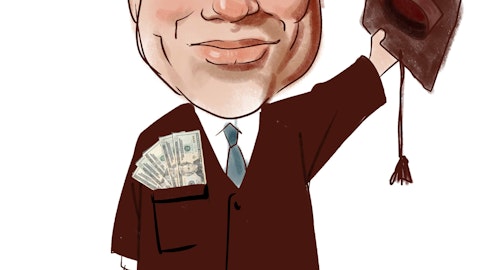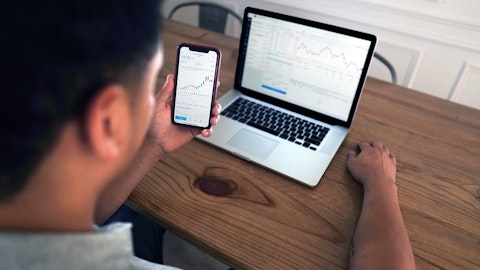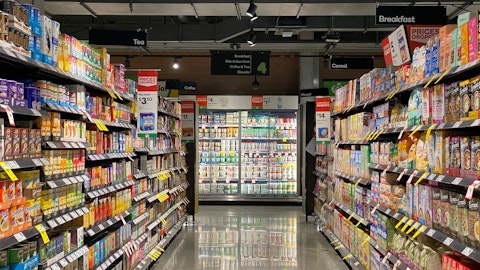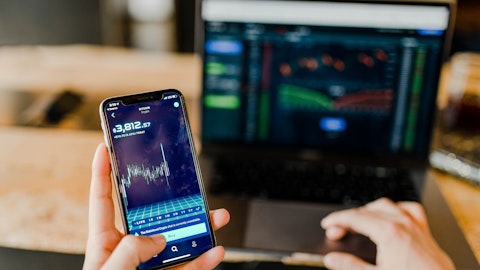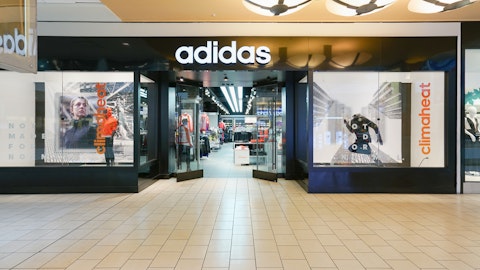Foot Locker, Inc. (NYSE:FL) Q3 2022 Earnings Call Transcript November 18, 2022
Foot Locker, Inc. beats earnings expectations. Reported EPS is $1.27, expectations were $1.11.
Operator: Good morning, and welcome to Foot Locker’s Third Quarter 2022 Financial Results Conference Call. At this time, all participants are in a listen-only mode. Later, we will conduct a question-and-answer session. This conference call may contain forward-looking statements that reflect management’s current views of future events and financial performance. Management undertakes no obligation to update these forward-looking statements, which are based on many assumptions and factors, including the impact of COVID-19, effects of currency fluctuations, customer preferences, economic and market conditions worldwide and other risks and uncertainties described more fully in the company’s press release and reports filed with the SEC, including the most recently filed Form 10-K or Form 10-Q.
Any changes in such assumptions or factors could produce significantly different results, and actual results may differ materially from those contained in the forward-looking statements. Please note that this conference call is being recorded. I will now turn the call over to Robert Higginbotham, Vice President of Investor Relations. Mr. Higginbotham, you may begin.
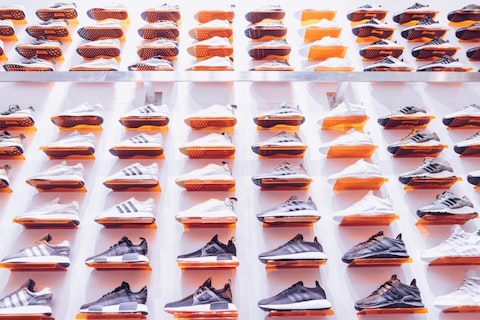
Photo by Edgar Chaparro on Unsplash
Robert Higginbotham: Thank you, operator. Welcome, everyone, to Foot Locker, Inc.’s Third Quarter Earnings Call. Today’s call will reference certain non-GAAP measures. A reconciliation of GAAP to non-GAAP results is included in this morning’s earnings release. To remind everyone, in our first quarter release, we updated our definition of non-GAAP earnings to exclude all minority investment gains and losses, and our third quarter and year-to-date non-GAAP results for 2021 have been recast to reflect that. Also note, we have a slide presentation posted on our Investor Relations website with information that will be referenced during the call. Today, we’ll begin our prepared remarks with Mary Dillon, President and Chief Executive Officer; Frank Bracken, Executive Vice President and Chief Operating Officer will discuss our operations and progress on our growth initiatives in more detail.
Andrew Page, Executive Vice President and Chief Financial Officer, will then review our quarterly results and financial position in more detail and provide color on our updated 2022 guidance. Following our prepared remarks, Mary, Frank and Andrew will respond to your questions. With that, I’ll now turn it over to Mary.
Mary Dillon: Thank you, Rob, and good morning, everyone. Thank you for joining us. Let me start by saying how honored I am to join Foot Locker in this fast-growing industry at such a dynamic time and with such momentum on our business. Thanks to the hard work, dedication and expertise of our teams across the organization as well as a resilient customer base, we delivered better-than-expected results despite operating in a volatile environment, including inflationary pressure on the consumer around the globe. Our total sales, excluding changes in currency, increased by 3.3%, with comps up 0.8% against record results from last year, driving adjusted EPS of $1.27 above our original expectations. And given strong momentum coming out of the quarter, we are increasing our outlook for the rest of the year, which Andrew will review later in the call.
But first, I want to provide an overview on a few topics. Why I chose to join Foot Locker, how I’ve spent my time during the first 90 days, the opportunities I see ahead, some of the early actions we’ve taken and finally, an update on our brand performance, diversification efforts and vendor relationships. So why did I choose to join Foot Locker? Let me start with the category, sneakers are fun. I come in with a true love for the product, which has only grown every day that I’ve been here, along with the number of sneakers that I have. And this is a growth category with a long runway ahead where the intersection of sport, fitness, fashion and the casualization of society and the tailwinds for sneakers, I believe, will be persistent for many years to come.
And much like beauty, sneaker category is driven by passionate enthusiasts who are deeply engaged in the category, products that allow for individual expressions that are fun to shop for and where newness and innovation matters. Also, sneakers are affordable luxury, a dynamic that we believe is helping to keep our category resilient in the face of steep inflationary pressures. Also like beauty, this is a category where shoppers value both in brick-and-mortar and digital experience. Now on to Foot Locker itself with nearly 50 years of heritage after playing a key role in making the category what it is today, Foot Locker has a tremendous amount of brand awareness and latent brand equity that I believe is not yet fully tasked. We are grounded in the history and culture of street basketball, youth culture, sneakerhead coolness and Foot Locker is squarely at the intersection of sports, fashion and trend, making our brand equity more relevant than ever.
In addition to the company’s rich heritage, our people are a true asset. The frontline store associates are stripers and blue shirts, love sneaker culture and our experts in the category. And this creates an energy in the stores that is a key competitive advantage. Also, we have one of the most diverse young workforces in retail, and we have thousands of associates throughout our company that have built their careers here in the field and corporate offices often after starting as part timers in high school. Lastly, Foot Locker is a company that has a strong commitment to community, which is an important part of both the corporate culture and how we go to market. So during my first 90 days, I’ve spent my time visiting stores and getting to know the skill team addressing the company’s overall capabilities and specifically our technology needs, getting to know many of our vendors as well as talking to investors to understand their perspective and what they would like to see from us.
So what are the opportunities I see? My early assessments have certainly validated all the reasons I was excited to join the company and have also shut light on where I see opportunities to become more efficient and more relevant in order to grow both our top and bottom lines. At a high level, is looking for ways to simplify the business to make sure we’re focused on the areas that hold the most strategic value and will generate the most return. And it also includes shifting our approach in many ways from being product led to consumer led, which will allow us to create a consumer-driven demand engine that can grow our market share and even the category by expanding our customer base as well as our share of wallet with existing customers. The areas where we will be the most focused are our omnichannel presence and capabilities, our loyalty program and overall digital marketing strategies and the technology platform, which enables those efforts, as well as continuing our cost optimization work.
Now one of the biggest opportunities we have is to create a richer omnichannel experience starting with e-commerce. Without having a specific target in mind yet, I believe at 16%, our e-commerce penetration is below where it should and can be, which means there’s an opportunity to capture more online-only sales; and more importantly, build our omnichannel customer base. Our current omnichannel customers in the U.S. spend nearly 4x the amount of our single-channel shoppers. Yet they represent only 6% of our customer base, which leads to a vast opportunity to improve our engagement with customers across our channels and attract more of their spending dollars. I also see a tremendous opportunity to further refine and evolve our FLX loyalty program that was launched just a few years ago.
While we’re already capturing a considerable amount of our sales through members of FLX, I see more opportunity to improve the value proposition of the program, drive more engagement with our members through personalization and ultimately attract more members and capture more share of wallet of our existing customers. In technology, we’re in the process of reviewing our foundational needs as well as making sure we’re building the right tools and capabilities to support those efforts in omnichannel and marketing. Having a stronger backbone and technology enablers will be a key priority for us going forward. While many plans are still taking shape, we’ve begun to take some early actions in some of the key areas I just discussed. Given the importance of technology and marketing, we’ve made some leadership changes in those areas and are in the process of actively recruiting best-in-class talent for key roles.
As part of our effort to simplify the business and focus on the most productive uses of our resources, we’ve decided to halt Foot Locker’s entry into Japan, and we have also decided to wind down two of our joint ventures in Europe. And Frank will elaborate on these strategic actions in a moment. Touching now on our assortment, some of our brand highlights and our vendor relationships. As the quarter progressed, we identified strong demand signals within basketball sneaker culture and kids, and we were able to partner with Nike to serve more customers in those categories, a trend we expect to continue into the fourth quarter. We, therefore, expect to end the year with a higher mix of Nike sales than we originally anticipated in addition to the strong demand we’ve seen across our portfolio.
Also in coming to Foot Locker, I was excited to see expanding brand diversification of the company because as in other consumer categories with high engagement like beauty, choice and variety is something that consumers demand. As the category grows and customers realize they can build a sneaker wardrobe, their appetite for variety and desire for choice is growing, and we know that 80% of our best customers already buy three or more brands. Given we are underpenetrated in virtually all of our brands outside of our top vendor, we continue to see opportunity to bring the customer a broader and richer set of product offerings across brands and categories. And we believe our third quarter results are further evidence that our efforts to broaden our portfolio are driving growth across multiple brands and helping us expand our customer base.
Our overall comps increased by 0.8% as we continue to see momentum in our non-Nike sales at our core banners, which were up mid-single digits, with most of our top 20 vendors posting strong growth. As we continue to deepen our partnerships across our portfolio, let me congratulate Bjørn Gulden as the next CEO of adidas, which grew mid-single digits in the quarter. As one of our biggest brands, we are excited to work with Bjørn and team to continue our enhanced relationship, including deeper product access across their portfolio as well as enhanced store presentations, which will reach approximately 300 doors globally by the end of this fiscal year. I’d also like to congratulate Arne Freundt for his appointment as the new CEO of Puma, which grew high single digits.
Earlier this week, we’re excited to announce an expanded partnership with Puma to reach next-generation customers through exclusive basketball and other elevated collaborations. Building on the success of the LaMelo Ball franchise, we are continuing our exclusive access with the MB.02, which launched last month. Beyond basketball, we’ll be launching several collaborative projects with musicians and fashion designers as well as an exclusive partnership with CoComelon in Kids. And we will be adding even more energy to the category and our Puma assortment through incremental hype drops, more exclusive, shared marketing partnerships and elevated experiences in-store and online. Moving on to the rest of the portfolio. We continue to see outsized gains in brands like New Balance, which was up nearly 70% this quarter; Crocs and Converse, which were both up over 25%; and UGG, which grew nearly 50%.
And while apparel overall was softer this quarter, our controlled brands continue to perform, growing over 50%, driven by strong fleece and outerwear performance through our CSG and Locker brands. And Pro Standard, one of the black-owned brands we support through our LEAD program has grown into a top 10 apparel brand through its successful local market streetwear focus on the license business. Now overall, we are very proud of the progress we’re making in remixing our vendor brand portfolio to be a more comprehensive multi-brand retailer and serving consumers with more sneaker choice. Looking at the holiday, we are encouraged by the momentum in the business, and we’re excited about our plans for holiday across our product assortment and how we’ll be connecting with customers.
With product, we have a strong launch lineup, including key releases of Jordan Retros, follow-up launches of Melo Ball 2, new Crocs collabs with Ron English and Puma x Paw Patrol to name just a few. UGG will also be a key brand for us this season as it continues to dominate the holiday time period through their comfort icon. New Balance continues to become a much larger part of our business, and we’re very happy about the holiday and 2023 product pipeline. And we’re excited for Champs Sports to partner with Gymshark around a unique opportunity to be the first brick-and-mortar retailer to carry that dynamic fitness apparel brand in the U.S. We also continue our rollout of ON and HOKA, both of which are getting traction with our existing customers and helping us attract new customers, and we continue to partner with them to build accelerated growth plans in the seasons ahead.
In marketing, for holiday this year, we are launching our first ever truly integrated global campaign with Foot Locker Holiday House Party, featuring a holiday party for sneaker fans around the world, this campaign leads with Foot Locker as a brand by showcasing our stripers in addition to musicians and online personalities to position Foot Locker as your sneaker home for the holiday. Also, we’re entering the metaverse by launching a Kids Foot Locker House of Play experience within Club Roblox, where virtual stripers will encourage players through a series of mini games in order to earn points to buy virtual sneakers. In summary, in addition to continuing down the path of offering an exciting range of brand options for our customers, giving incremental focus to our omnichannel capabilities and loyalty programs, continuing the cost optimization work that’s underway and further simplifying our business, I see a tremendous amount of opportunity ahead for Foot Locker, Inc., and I look forward to updating you on our new strategies as we move forward.
And now let me hand it over to Frank to discuss some of our operations and growth drivers in more detail.
Frank Bracken : Thank you, Mary, and good morning, everyone. This morning, I will take you through an update of our banner performance and our real estate strategies then discuss our supply chain network upgrade and finally, the moves we’ve taken to simplify our business. Starting with performance by our portfolio of banners and geographies. In North America, our overall comps declined modestly by 1.1%, with Foot Locker up high single digits on strong basketball trends and gains in all major back-to-school markets. Kids Foot Locker increased mid-single digits, driven by broad-based strength across brands and effective marketing campaigns around back-to-school. Champs Sports was down low double digits, though still up compared to 2019, as we distorted inventory to our Foot Locker and Kids Foot Locker banners.
WSS, our off-mall value banner focused on Hispanic communities contributed $162 million in sales for the quarter, and comps up low single digits, improving from the down low single digits in the second quarter. While the WSS consumer continues to be pressured and traffic remains impacted, our execution in-store helped drive conversion improvement, resulting in positive comp growth for the banner despite the tough environment. Importantly, the new WSS stores we opened so far in 2022 are performing in line with their sales plans. And we continue to see encouraging results from our WSS loyalty program, which is delivering over 80% of sales across the entire fleet. This past quarter marked the first full year of Foot Locker owning this well-positioned business.
And one year later, as we strategically expand the WSS store footprint, we continue to gain confidence in the business. The Hispanic population is the fastest-growing demographic segment in the United States, with the Census Bureau projecting the Hispanic American population to reach 72 million by the end of this decade, an addition of 10 million consumers from 2020. With its special connection to that community, and only 108 stores today, WSS has an incredible runway for growth in both its core markets in the West and Southwest as well as new regions where the Hispanic population is forecasted to grow the fastest. We will mark the beginning of our expansion into the Southeast region with our first Florida store later this quarter. We still expect to deliver approximately $600 million of sales this year, and we are confident in favorable consumer demographics, strong market planning and merchandising plans and a robust loyalty program will make WSS the next $1 billion retail banner in our portfolio.
Moving on to other regions. Overall comps in Europe grew 0.8% with ongoing strength in key markets, led by France, Italy and Spain. We also began our rollout of BOPIS in Europe, elevating our omnichannel experience in approximately 400 stores across the region. In Asia Pacific, comps increased 36.5%, driven by the ongoing loosening of travel restrictions in some Asian markets, lapping some store closures last year due to COVID and improving inventory and receipt flow. And finally, atmos continued its strong trends in connection to sneaker culture, contributing $40 million to sales, up double digits versus their results last year, led by a strong performance in their core market, Japan. Moving on to real estate. While our fleet includes a strong portfolio of mall-based stores, we also continue to deliberately pivot our business also, where it makes sense to be more closely connected to our consumers and communities as well as provide us the opportunity to build a larger store that can offer a better expression of brands, categories and genders.
Our community and Power Store rollout is an important part of that strategy. In the third quarter, we opened or converted nearly 20 new Foot Locker community and Power Stores across the globe, giving us approximately 150 doors in these formats on the way towards our goal of 300 globally by 2024. Our community and Power Stores continue to deliver sales, both above their plan and to outcome their regional benchmarks in the fleet by several hundred basis points, giving us ongoing conviction in our strategy. Including WSS, we expect our store count in North America to be approximately 25% off-mall by the end of the year. And we will continue to push that penetration higher over time as we roll out more community and Power doors, expand WSS and strategically pivot other stores off-mall as well.
Next, I want to update you on our distribution network in the United States, our largest retail market as we work to optimize our supply chain and get closer to our customers in order to better serve them. With the full wind down of Eastbay operations to be complete by year’s end, we will be closing our Wausau, Wisconsin distribution facility at the end of our fiscal year. Prior to 2021, we served the entire country out of that facility and another centrally located DC in Kansas and therefore, had two-day delivery coverage of only 38% of the U.S. In Q3 2021, we opened our Camp Hill facility in Pennsylvania to serve the East Coast more directly, which improved our standard two-day delivery coverage to 75% of the U.S. And I’m now happy to announce the opening of our new state-of-the-art distribution center in Reno, Nevada, which will serve the Western part of the country, cutting shipping times in the area by more than 50%.
With the Reno opening, we now have a truly regional network system, which will take our two-day standard shipping coverage to over 95% of the United States. As we explore ways to enhance our omnichannel capabilities to better serve consumers, this distribution backbone and ability to deliver a two-day shipping promise to most of the country will be an important foundation. Lastly, as Mary mentioned in her opening comments, we are intently looking for ways to simplify our business model so that we can invest resources and allocate capital to their highest and best use. As part of that effort, we have decided to hault the Foot Locker banners and treat into Japan, which was scheduled for Q4 of this year. I would like to thank and commend our teams for their great work in preparing us to enter that market.
However, given the strong presence and performance of atmos in Japan, we have decided to reallocate capital to elevate the atmos omnichannel experience to grow and serve consumers in this vibrant sneaker culture market. We have also wound down two separate joint ventures we previously had in Europe, one, where we were minority partners in stores operating in the Benelux region; and another where we were majority partners in a venture that operated stores in Eastern Europe. These moves are in addition to the sale of our Eastbay team sales business this summer and the wind down of the eastbay.com consumer business that will be complete by the end of this year. Taken together, these moves helped to simplify our business operations and allow us to focus our teams and corporate services on our largest and most profitable banners and operating units.
So in summary, our core banners delivered solid results during the third quarter, led by the performance of our community and Power Stores as we continue to strategically pivot our business off-mall. We continue to remain excited about the growth potential we see in our WSS banner, serving the Hispanic community. We’ve enhanced our distribution network to better serve both our stores and our online customers in our critical U.S. market. And we are simplifying our operations so that we can continue to invest in the banners and regions that generate the greatest return on capital and effort. I’ll now hand the call over to Andrew.
See also Lithium Stocks List: 15 Biggest Companies and Dividend Champions List By Yield.
Andrew Page: Thank you, Frank, and good morning, everyone. Our third quarter is a wonderful demonstration of Foot Locker’s positioning in the market, our solid execution and further evidence that our strategies are working. When we updated you last quarter, we discussed the strong start to back-to-school being preceded by a much softer than expected June and early July such that we were hesitant to over extrapolate the strong late July and early August trends beyond the back-to-school season. But given solid demand improved access to inventory and the execution of our teams, we were able to sustain much of that momentum throughout the quarter, with August up mid-single digits; September up low single digits; and October, up against our toughest multiyear comparison of the quarter, down mid-single digits.
Overall, our third quarter total sales decreased slightly 0.7% compared to the record levels achieved last year, but were up 3.3%, excluding the impact of foreign currency. On a comparable basis, sales increased 0.8% with our non-Nike sales in our core banners growing mid-single digits as we remain on strategy with the rebalancing of our product assortment. By category, footwear comped up low single digits, while apparel and accessories fell mid-single digits. Comparable sales in our stores increased 4.7%. Our digital channel comped down 14.5% with overall penetration at 16.3%. This is down from 19.8% last year, but still above the 15.3% from 2019. Moving down the income statement. Gross margin for the quarter declined 270 basis points to 32.0%.
Merchandise margins fell by 280 basis points, driven by higher markdowns as the promotional environment remained elevated. Occupancy leveraged slightly by 10 basis points still aided somewhat by the layering of WSS and atmos into our base. As a reminder, WSS and atmos carry somewhat lower merchandise margin though lower occupancy makes them overall gross margin neutral to our total business. At quarter end, our inventories were 29.5% above last year but down from the 52% year-over-year increase we noted at the end of Q2. On SG&A, let me start by providing you with an update on our $200 million cost optimization program. This is the largest, most comprehensive review of our cost structure the company has ever pursued. And I am incredibly proud of the team’s work and progress in both identifying a wide range of opportunities and beginning to execute on them.
This has truly been an enterprise-wide effort that is intended to not only take cost out of the business but to also ensure that we can remain nimble in a dynamic industry across business cycles. Given the scope of the effort, the opportunities we are targeting are very broad and will span efficiencies at corporate and store levels, including everything from procurement to store operations. In order to properly implement, we have slowed execution in some areas that we still expect to fully realize the full $200 million over time. In the fourth quarter, we expect to realize approximately $9 million of SG&A savings from the program on top of the approximately $9 million we realized in the third quarter, bringing the total for the year to approximately $18 million.
For the third quarter, our SG&A rate came in at 21.5%, representing deleverage of approximately 60 basis points, driven mostly by labor wage inflation, which continues to grow at a rapid pace. This deleverage was offset by approximately $9 million of savings from our cost optimization program. Depreciation expense was $52 million versus $49 million last year, driven mainly by the inclusion of WSS and atmos. Our non-GAAP tax rate came in at 31.7% above last year’s rate of 28.0%, driven by the geographic mix of our income. Now turning to our balance sheet. We ended the quarter with $351 million of cash and $454 million of debt. We paid $37 million in dividends and did not repurchase any stock during the quarter, given our historical preference to remain relatively net debt neutral.
Moving on to our outlook for the rest of the year. Following our better-than-expected results in the third quarter, the solid momentum in demand and our strong inventory position, we are increasing our forecast for the fourth quarter and the full year. For the year, we are raising our guidance for non-GAAP EPS to the range of $4.42 to $4.50, up from our prior range of $4.25 and to $4.45. Given it is the last quarter of the year, we are also providing updated guidance in terms of the fourth quarter, though we will not be providing quarterly guidance on an ongoing basis. Now for guidance on the fourth quarter. With our non-Nike sales in core banners up mid-single digits in the third quarter and nearly 10% year-to-date, our efforts in elevating and driving growth in other brands has progressed more quickly than we expected at the beginning of the year.
Meanwhile, as Mary mentioned, we’ve been able to partner with Nike to fulfill incremental demand that we’ve identified in that brand. Overall, we feel good as we ended Q3 with a strong inventory and receipt position in high-quality products. As a result, we now expect our fourth quarter comps to decline by 6% to 8%, which has improved from our prior expectation of down double digits. That improvement is despite a roughly $50 million negative impact from no longer selling YEEZY. We plan to open approximately 20 new doors in the fourth quarter while closing a total of approximately 85 stores. Overall, our store count will be down approximately 4% in 2022 with square footage down slightly as we convert more stores to larger formats. With FX as an ongoing drag and having fully anniversary the acquisitions of WSS and atmos, we expect our total sales to fall by 8% to 10% or 2 percentage points below our comp.
We expect our gross margin to decline by 370 basis points to 400 basis points to 29.0% to 29.3%, driven by occupancy deleverage on the down comp and somewhat larger markdown pressure compared to Q3, but in line with our expectations. Note, that while the promotional environment has continued to intensify, we are receiving more support from our vendors to help fund markdown dollars. Historically, we’ve managed a collection of four basic inventory levers, cancellations, RTVs, push outs and vendor allowances or VAs. We’ve worked closely with all of our brand partners to balance all of these levers. Each brand partner utilizes all of them. But this year, based on heavier overall inventory levels, VAs are higher than usual. At the end of the year, we still expect our inventories to remain up versus last year, which will put us in a strong position to start 2023.
I should also note that the removal of the YEEZY product does not have a material impact on our gross margin as the margin on that product look close to the company average. Moving to SG&A. We expect to deleverage by 90 basis points to 100 basis points to 23.3% to 23.4%, driven by ongoing wage inflation and the deleverage from the down comp, partially offset by an estimated approximately $9 million of savings from our cost optimization program. Note, we do not expect to buy back any shares during the fourth quarter. As a result, we expect our fourth quarter non-GAAP earnings per share to be in the range of $0.45 to $0.53. Lastly, while we won’t be giving 2023 guidance until we report our fourth quarter earnings in February, we do want to remind everyone that we will have a 53rd week in our 2023 fiscal year.
In closing, we are excited about the momentum in the business, the resiliency we have seen in our customers and our growing ability to better serve them. And we look forward to updating you on our progress in Q4. With that, operator, please open the call for questions.
Q&A Session
Follow Foot Locker Inc. (NYSE:FL)
Follow Foot Locker Inc. (NYSE:FL)
Operator: And our first question will come from Bob Drbul of Guggenheim.
Robert Drbul : Good morning. And Mary, congrats to joining Foot Locker. Welcome, and congrats on a great quarter.
Mary Dillon: Thank you, Bob. I appreciate that.
Robert Drbul: I guess the first question I had actually for you, Mary, is can you just help us understand your plan for working with Nike and managing that relationship? Can we just start there?
Mary Dillon : Sure. Well, first of all, thank you for your comments, and I’m really proud and honored to be the new CEO of Foot Locker. I’m really proud of the quarter that our team delivered the momentum that we see in our business. And actually, one of the things that really struck me is smart as I started was I love our brand diversification efforts. I mean, I know from other consumer categories like beauty, choice is something that consumers want, and we see that at Foot Locker, right, that our best guests are buying multiple brands. And so a large part of our momentum is driven by the fact that we have elevated a number of brands partner with them, have a lot of new brands to the assortment. Having said that, of course, our relationship with Nike is very important.
It’s strong. We’ve been able to partner with Nike to provide our customers with some increased demand signals that we saw in the quarter in areas that we do particularly well together, basketball, sneaker culture kids. So to me, I see this as a multifaceted relationship over many years that I’ll continue to build on.
Robert Drbul: Great. And just on a follow-up to that. I don’t know if this is for you or for Andrew, but I think both may comment to improved access to other inventory. Can you just maybe address that and elaborate a little bit more what you’ve seen and sort of what you’ve been able to get your hands on that you didn’t have sort of in the quarter or going into the quarter?
Mary Dillon: Great. I’ll let Frank take that. Frank?
Frank Bracken : Bob, it’s Frank. So look, we’re constantly communicating and looking for opportunities together with our partners in Nike’s, especially around the sharp points of the basketball category, sneaker culture and then, of course, our kids business. So you heard in my opening comments around the strength of our Power and community stores and how well they’re performing with the core consumer base. And then think about House of Hoops and the share point provides basketball. And then you guys know KFL is the only kids-focused concept in athletic specialty. So those are strategies are highly complementary to Nike’s strategy. And then finally, as Mary said, we saw some demand signals, and we were collectively able to pick up on the signals and react together in a way that was on strategy for both companies. And to me, that’s the definition of a strong partnership. So that’s what happened throughout the quarter. .
Operator: The next question comes from Tom Nikic of Wedbush Securities.
Tom Nikic : I guess following up on the Nike point there. I think at the start of the year, you said that Nike would fall below 55% of total sales by the end — I guess, by the fourth quarter and you’re kind of coming in better than that. Is the plan that Nike will still kind of fall below that 55% level over time? And it’s just — I mean, taking a little bit longer because you kind of working with them a little bit closer? Or — do you think maybe the overall reduction in the Nike penetration will not be as dramatic as you communicated as far as this fiscal year?
